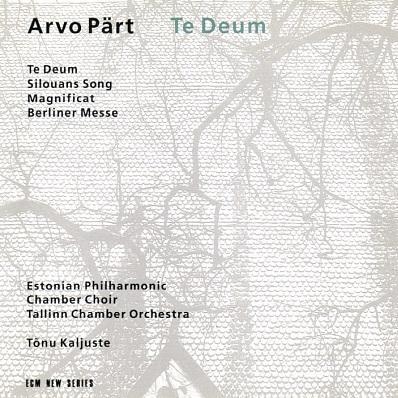Post by Slinger on Oct 31, 2019 22:27:21 GMT
 |
Yes, more bloomin' Arvo Pärt from me. I really enjoy his music, and it was either this or Mahler, so think yourselves lucky.
Te Deum is a setting of the Latin Te Deum text, also known as the Ambrosian Hymn attributed to Saints Ambrose, Augustine, and Hilary, by Estonian-born composer Arvo Pärt, commissioned by the Westdeutscher Rundfunk in Cologne, Germany, in 1984. Dedicated to the late Alfred Schlee of Universal Edition, the WDR Broadcast Choir premiered the Te Deum under the direction of conductor Dennis Russell Davies on January 19, 1985. The Te Deum plays an important role in the services of many Christian denominations, including the Paraklesis (Moleben) of Thanksgiving in the Eastern Orthodox Church. Because of the unusual instrumentation Pärt employs, his Te Deum is not suited for use within the Orthodox Church. It was recorded on the ECM New Series label in 1993 by the Estonian Philharmonic Chamber Choir and Tallinn Chamber Orchestra under the direction of Tõnu Kaljuste. The piece is approximately thirty minutes long.
The Latin text of the Te Deum is made up of 29 lines of verse, each of which is the subject of one section of Pärt's composition. These 29 sections are not considered movements in the sense of traditional choral works because they are not separated by silences or pauses. Each line of text is introduced as plainsong before its augmentation in either a choral or instrumental texture. Although each of the piece's 29 sections follow this pattern, they function differently from the movements of traditional choral works because they are not punctuated by silences or pauses. With the notable exception of three silences, each section of the Te Deum flows directly into the succeeding one, with the wind-harp drone often serving as part of the sonic bridge between.
Next is Silouan’s Song, one of Pärt’s instrumental works based on a religious text in Russian. The text was written by St. Silouan (1866–1938), a Russian monk from Mount Athos, whose other text became the basis of one of Pärt’s most important works in recent years, Adam’s Lament. The work composed for string orchestra, with the subtitle My soul yearns after the Lord…, was also dedicated to the Archimandrite Sophrony, founder of the Monastery of St John the Baptist, in Essex, England.
This is followed by Pärt's Magnificat. Pärt scored the Latin text of the Magnificat canticle for five-part choir (SSATB) a cappella, with several divided parts. Its performance time is approximately seven minutes. The composition is in tintinnabuli style, a style which Pärt had invented in the mid-1970s.
The album closes with Pärt’s Berliner Messe. Commissioned for the 90th Katholikentag in Berlin in 1990, it was originally scored for SATB soloists and organ. It was first performed at St. Hedwig's Cathedral on 24 May 1990, the Feast of the Ascension, with Paul Hillier conducting the Theatre of Voices. Pärt later (1997) revised the piece for chorus and string orchestra. Pärt uses his tintinnabuli technique throughout, with movements taking many forms within that style—flowing from quietly reverent duets between parts to full chorus proclamations of faith.
The work consists of five movements of the Mass ordinary and three movements intended for the celebration of Pentecost: Kyrie, Gloria, Erster Alleluiavers (First Alleluia), Zweiter Alleluiavers (Second Alleluia), Veni Sancte Spiritus, Credo, Sanctus, and Agnus Dei. The fact that the mass was originally written for Pentecost is evidenced by the presence of the two Alleluias and the Veni Sancte Spiritus. However, Pärt has also set two Alleluia verses to permit the work to be used at Christmas. All five of these movements are marked "ad lib." in the score.
For anyone wishing to understand Arvo Pärt's "Tintinnabuli" which keeps getting mentions, there's a Wikipedia page here en.wikipedia.org/wiki/Tintinnabuli


